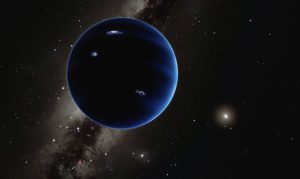In 1957, writer and director Edward Wood, known essentially as the creator of some of the worst B movies in cinematic history, released yet another stinker, Plan 9 From Outer Space, a black and white sci-fi about aliens who resurrect the dead of the Earth to do their evil bidding. Sixty-four years later, the quest for Planet 9 (sorry, not a sequel) may be wrapping up its search for the planet to replace Pluto, which fell from the graces of our solar system when it was declared a dwarf planet, thus rendering the count of our solar system to only eight planets, leaving many of us to wonder: What did my very educated mother just serve us nine of?
That’s precisely what astronomer Micheal Brown, who ironically consigned Pluto to wander outer space bereft of inclusion in our solar system, is asking. Brown, who is a researcher at the California Institute of Technology in Pasadena, became famous in astronomy circles when he declared Pluto planet non grata, which caused a planetary uproar in the astrophysicist community.
Essentially, Pluto didn’t make the cut because it failed to achieve “gravitational dominance” in the Kuiper Belt, a vast region on the outer edge of our solar system consisting of millions of small, icy objects, some as large as Pluto, which is approximately 751 miles in diameter. This lack of “gravitational dominance” meant Pluto was not attracting and dominating smaller objects (“icy space rocks”) in its vicinity, leading to its ignominious fate, a move that caused an immediate controversy.
Now, coincidentally, Brown believes he has found a planet, ie. Planet Nine, to replace the now-disgraced Pluto. Brown had no intention of finding a replacement for Pluto, saying “If I were prescient enough to have had all these ideas ahead of time and then demoted Pluto and found a new Planet Nine, then that would be brilliant — but it really is just a coincidence.”
The discovery of Planet Nine by Brown and co-researcher Konstantin Batygin is based on mathematical modeling and computer simulations, rather than direct observation. And, unlike Pluto, this new planet is massive, about 5,000 times the mass of Pluto, although this is a rough estimate subject to revision as new data is obtained.
This size differential is important because, with such a mass, Planet Nine would be able to establish gravitational dominance, thus meeting the criteria for admittance to the Earth’s planetary neighborhood. As Brown puts it, Planet Nine’s calculated mass makes it “the most planet-y of the planets in the whole solar system.”
Ironically, Planet Nine is intimately linked to the Kuiper Belt. Building on previous and concurrent research of other astronomers, whose work indicated that Kuiper belt objects (a surprisingly good name for underground Dutch New Wave band) were being pulled, clustered, and realigned by some mysterious force away from the Sun, Brown and Batygin hypothesized that the forces exerted were evidence of another planet.
This of course was an extremely important discovery, and one that led Brown to write in 2018, “This was something waiting to be found, something that both explained the old observations we were working on and also crystallized correct predictions about things we were completely unaware of. We like to think of this as the day that Planet Nine was born.”
In particular, Brown and Batygin felt there were six specific objects that indicated something cosmically cool was happening, determining their movements were occurring in close concert, a signal they argue that the objects were uniformly directed by a powerful outside force:
“It’s almost like having six hands on a clock all moving at different rates, and when you happen to look up, they’re all in exactly the same place,” says Brown. The odds of having that happen are something like 1 in 100, he says. But on top of that, the orbits of the six objects are also all tilted in the same way—pointing about 30 degrees downward in the same direction relative to the plane of the eight known planets.”
Of course, Brown’s and Batygin’s hypothesis has detractors because they lack direct evidence of the existence of Planet Nine. As NBC News reports, “ . . .some astronomers have suggested it doesn’t exist and the clustering of objects noted by Brown and Batygin is the result of ‘observation bias’ — since fewer than a dozen objects have been seen, their clustering might be a statistical fluke that wouldn’t be seen among the hundreds thought to exist.”
In particular, Kevin Napier, a physicist at the University of Michigan in Ann Arbor, published an analysis questioning Brown’s and Batygin’s conclusions, stating, “. . . that this sample provides no evidence for angular clustering.” In essence, Napier was arguing that the discoveries of the disturbed orbits of some of the objects in the Kuiper belt were an anomaly, a meaningless statistical mirage of sorts.
Napier tempered his criticism, however, adding, “I want to be very careful to mention that this does not kill Planet Nine. But it’s not good for Planet Nine.”(Is it me, or does that seem a bit passive-aggressive, maybe even “gravitationally dominant”?).
Gary Bernstein, an astronomer at the University of Pennsylvania, has his doubts, also, though with a different underlying perspective. Bernstein points out that the discovery of the objects by Brown and Batygin may be a form of cosmic coincidence combined with selection bias.

Source: astronomy.com
Bernstein said that the observations were taken only from one section of space, so looking elsewhere for observations is needed to build further evidence of Planet Nine’s existence. As Bernstein argues, “It’s important to know what you couldn’t see, in addition to what you did see.” (Is it just me, or does Bernstein sound a bit like a Zen monk?)
Undaunted, Brown and Batgin pushed back, saying, “All telescopic surveys contain observational biases. Correctly understanding and implementing these biases into our modeling is critical to correctly using the observations to extract orbital parameters of Planet Nine.” In fact, the duo redid their calculations, concluding “that the clustering remains significant at the 99.6\% confidence level.” This means that the astronomers believe there is very little chance they are observing an astronomical fluke (also a cool name for a Norwegian power-pop band).
In any case, the search goes on for Pluto’s replacement (Netflix’s new sci-fi drama?). Both Brown and Batygin are hoping they will get some significant supporting evidence, this time in the form of direct observations. The team is banking on the prowess of the Vera Rubin Observatory in El Peñón peak of Cerro Pachón, Chii, set to begin deep-space exploration in 2023.
According to the Vera Rubin website, the mission of the observatory ” . . . is to build a well-understood system that will produce an unprecedented astronomical data set for studies of the deep and dynamic universe, make the data widely accessible to a diverse community of scientists, and engage the public to explore the Universe with us.”
Meanwhile, we are left asking: If this discovery isn’t the elusive Planet Nine, can we get Pluto back, at least temporarily? Eight is not enough.
At Newsweed.com, we adhere to three simple principles: truth, balance, and relatability. Our articles, podcasts, and videos strive to present content in an accurate, fair, yet compelling and timely manner. We avoid pushing personal or ideological agendas because our only agenda is creating quality content for our audience, whom we are here to serve. That is why our motto is ”Rolling with the times, straining for the truth.”
Your opinion matters. Please share your thoughts in our survey so that Newsweed can better serve you.
Charles Bukowski, the Los Angeles beat poet that captured the depravity of American urban life once said, “There is something about writing poetry that brings a man close to the cliff’s edge.” Newsweed is proud to stand in solidarity and offer you a chance to get close to the cliff’s edge with our first Power of Poetry Contest. Are you a budding bard, a versatile versifier, a rhyming regaler? Do you march to the beat of iambic pentameter, or flow like a river with free verse? If so, here’s your opportunity to put your mad poetic chops to the test. Enter our poetry contest for bragging rights and an opportunity to win some cash!






